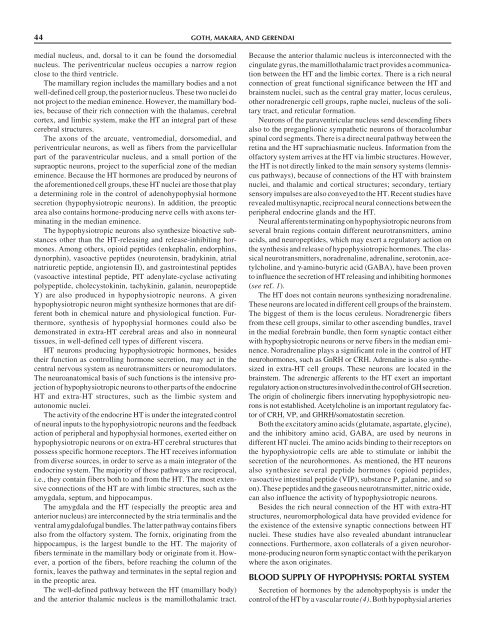Diagnosis and Management of Pituitary Tumors
Diagnosis and Management of Pituitary Tumors
Diagnosis and Management of Pituitary Tumors
Create successful ePaper yourself
Turn your PDF publications into a flip-book with our unique Google optimized e-Paper software.
44 GOTH, MAKARA, AND GERENDAImedial nucleus, <strong>and</strong>, dorsal to it can be found the dorsomedialnucleus. The periventricular nucleus occupies a narrow regionclose to the third ventricle.The mamillary region includes the mamillary bodies <strong>and</strong> a notwell-defined cell group, the posterior nucleus. These two nuclei donot project to the median eminence. However, the mamillary bodies,because <strong>of</strong> their rich connection with the thalamus, cerebralcortex, <strong>and</strong> limbic system, make the HT an integral part <strong>of</strong> thesecerebral structures.The axons <strong>of</strong> the arcuate, ventromedial, dorsomedial, <strong>and</strong>periventricular neurons, as well as fibers from the parvicellularpart <strong>of</strong> the paraventricular nucleus, <strong>and</strong> a small portion <strong>of</strong> thesupraoptic neurons, project to the superficial zone <strong>of</strong> the medianeminence. Because the HT hormones are produced by neurons <strong>of</strong>the aforementioned cell groups, these HT nuclei are those that playa determining role in the control <strong>of</strong> adenohypophysial hormonesecretion (hypophysiotropic neurons). In addition, the preopticarea also contains hormone-producing nerve cells with axons terminatingin the median eminence.The hypophysiotropic neurons also synthesize bioactive substancesother than the HT-releasing <strong>and</strong> release-inhibiting hormones.Among others, opioid peptides (enkephalin, endorphins,dynorphin), vasoactive peptides (neurotensin, bradykinin, atrialnatriuretic peptide, angiotensin II), <strong>and</strong> gastrointestinal peptides(vasoactive intestinal peptide, PIT adenylate-cyclase activatingpolypeptide, cholecystokinin, tachykinin, galanin, neuropeptideY) are also produced in hypophysiotropic neurons. A givenhypophysiotropic neuron might synthesize hormones that are differentboth in chemical nature <strong>and</strong> physiological function. Furthermore,synthesis <strong>of</strong> hypophysial hormones could also bedemonstrated in extra-HT cerebral areas <strong>and</strong> also in nonneuraltissues, in well-defined cell types <strong>of</strong> different viscera.HT neurons producing hypophysiotropic hormones, besidestheir function as controlling hormone secretion, may act in thecentral nervous system as neurotransmitters or neuromodulators.The neuroanatomical basis <strong>of</strong> such functions is the intensive projection<strong>of</strong> hypophysiotropic neurons to other parts <strong>of</strong> the endocrineHT <strong>and</strong> extra-HT structures, such as the limbic system <strong>and</strong>autonomic nuclei.The activity <strong>of</strong> the endocrine HT is under the integrated control<strong>of</strong> neural inputs to the hypophysiotropic neurons <strong>and</strong> the feedbackaction <strong>of</strong> peripheral <strong>and</strong> hypophysial hormones, exerted either onhypophysiotropic neurons or on extra-HT cerebral structures thatpossess specific hormone receptors. The HT receives informationfrom diverse sources, in order to serve as a main integrator <strong>of</strong> theendocrine system. The majority <strong>of</strong> these pathways are reciprocal,i.e., they contain fibers both to <strong>and</strong> from the HT. The most extensiveconnections <strong>of</strong> the HT are with limbic structures, such as theamygdala, septum, <strong>and</strong> hippocampus.The amygdala <strong>and</strong> the HT (especially the preoptic area <strong>and</strong>anterior nucleus) are interconnected by the stria terminalis <strong>and</strong> theventral amygdal<strong>of</strong>ugal bundles. The latter pathway contains fibersalso from the olfactory system. The fornix, originating from thehippocampus, is the largest bundle to the HT. The majority <strong>of</strong>fibers terminate in the mamillary body or originate from it. However,a portion <strong>of</strong> the fibers, before reaching the column <strong>of</strong> thefornix, leaves the pathway <strong>and</strong> terminates in the septal region <strong>and</strong>in the preoptic area.The well-defined pathway between the HT (mamillary body)<strong>and</strong> the anterior thalamic nucleus is the mamillothalamic tract.Because the anterior thalamic nucleus is interconnected with thecingulate gyrus, the mamillothalamic tract provides a communicationbetween the HT <strong>and</strong> the limbic cortex. There is a rich neuralconnection <strong>of</strong> great functional significance between the HT <strong>and</strong>brainstem nuclei, such as the central gray matter, locus ceruleus,other noradrenergic cell groups, raphe nuclei, nucleus <strong>of</strong> the solitarytract, <strong>and</strong> reticular formation.Neurons <strong>of</strong> the paraventricular nucleus send descending fibersalso to the preganglionic sympathetic neurons <strong>of</strong> thoracolumbarspinal cord segments. There is a direct neural pathway between theretina <strong>and</strong> the HT suprachiasmatic nucleus. Information from theolfactory system arrives at the HT via limbic structures. However,the HT is not directly linked to the main sensory systems (lemniscuspathways), because <strong>of</strong> connections <strong>of</strong> the HT with brainstemnuclei, <strong>and</strong> thalamic <strong>and</strong> cortical structures; secondary, tertiarysensory impulses are also conveyed to the HT. Recent studies haverevealed multisynaptic, reciprocal neural connections between theperipheral endocrine gl<strong>and</strong>s <strong>and</strong> the HT.Neural afferents terminating on hypophysiotropic neurons fromseveral brain regions contain different neurotransmitters, aminoacids, <strong>and</strong> neuropeptides, which may exert a regulatory action onthe synthesis <strong>and</strong> release <strong>of</strong> hypophysiotropic hormones. The classicalneurotransmitters, noradrenaline, adrenaline, serotonin, acetylcholine,<strong>and</strong> γ-amino-butyric acid (GABA), have been provento influence the secretion <strong>of</strong> HT releasing <strong>and</strong> inhibiting hormones(see ref. 1).The HT does not contain neurons synthesizing noradrenaline.These neurons are located in different cell groups <strong>of</strong> the brainstem.The biggest <strong>of</strong> them is the locus ceruleus. Noradrenergic fibersfrom these cell groups, similar to other ascending bundles, travelin the medial forebrain bundle, then form synaptic contact eitherwith hypophysiotropic neurons or nerve fibers in the median eminence.Noradrenaline plays a significant role in the control <strong>of</strong> HTneurohormones, such as GnRH or CRH. Adrenaline is also synthesizedin extra-HT cell groups. These neurons are located in thebrainstem. The adrenergic afferents to the HT exert an importantregulatory action on structures involved in the control <strong>of</strong> GH secretion.The origin <strong>of</strong> cholinergic fibers innervating hypophysiotropic neuronsis not established. Acetylcholine is an important regulatory factor<strong>of</strong> CRH, VP, <strong>and</strong> GHRH/somatostatin secretion.Both the excitatory amino acids (glutamate, aspartate, glycine),<strong>and</strong> the inhibitory amino acid, GABA, are used by neurons indifferent HT nuclei. The amino acids binding to their receptors onthe hypophysiotropic cells are able to stimulate or inhibit thesecretion <strong>of</strong> the neurohormones. As mentioned, the HT neuronsalso synthesize several peptide hormones (opioid peptides,vasoactive intestinal peptide (VIP), substance P, galanine, <strong>and</strong> soon). These peptides <strong>and</strong> the gaseous neurotransmitter, nitric oxide,can also influence the activity <strong>of</strong> hypophysiotropic neurons.Besides the rich neural connection <strong>of</strong> the HT with extra-HTstructures, neuromorphological data have provided evidence forthe existence <strong>of</strong> the extensive synaptic connections between HTnuclei. These studies have also revealed abundant intranuclearconnections. Furthermore, axon collaterals <strong>of</strong> a given neurohormone-producingneuron form synaptic contact with the perikaryonwhere the axon originates.BLOOD SUPPLY OF HYPOPHYSIS: PORTAL SYSTEMSecretion <strong>of</strong> hormones by the adenohypophysis is under thecontrol <strong>of</strong> the HT by a vascular route (4). Both hypophysial arteries















